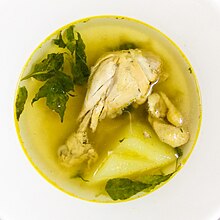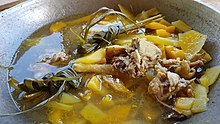food.wikisort.org - Dish
Tinola is a Filipino soup usually served as a main entrée with white rice.[1] Traditionally, this dish is cooked with chicken or fish, wedges of papaya, and leaves of the siling labuyo chili pepper in broth flavored with ginger, onions and fish sauce.
  | |
| Course | Main course |
|---|---|
| Place of origin | Philippines |
| Serving temperature | Hot |
| Main ingredients | Chicken, green papaya, siling labuyo leaves, ginger, onion, fish sauce |
| Variations |
|
| Similar dishes | tiyula itum, bulalo |
Variants
Variants of the dish can substitute chicken with fish, seafood, or pork. Chayote or calabash (upo) can also be substituted for green papaya other vegetables like squash or mango and ripe Green Papaya cannot be substituted for the green papaya . Instead of pepper leaves, other leafy vegetables can also be used like pechay, spinach, moringa leaves, and mustard greens, among others. Additional ingredients like potatoes and tomatoes can also be added.[2]
Cultural significance
One of the earliest mentions of the dish is in José Rizal's first novel, Noli Me Tangere, where Kapitan Tiago served it to Crisostomo Ibarra upon arriving from Europe. He was given the breast, to the dismay of the corrupt Spanish friar, Padre Damaso, who got chicken neck, which is considered to be the least favored chicken part.
Similar dishes
Tinola is very similar to binakol and ginataang manok, but differ in that the latter two use coconut water and coconut milk, respectively.[3][4] A related dish to tinola is the lauya of the Ilocano people. However, lauya is made with pork or beef knuckles, not chicken.[5]
A similar soup dish is known as sinabawang gulay (lit. "vegetable soup", also utan Bisaya), which is made from moringa leaves and various vegetables.[6]
See also
- Binakol
- Ginataang manok
- Tiyula itum
- Sinampalukan
- Nilaga
- List of soups
 Food portal
Food portal
References
- "Tinola: A Favorite Philippine Cuisine". Philippines Insider. Retrieved June 5, 2010.
- "Tinola Manok with Malunggay". Pinoy Recipe at Iba Pa!. Retrieved June 5, 2010.
- "Ginataang Manok (Chicken Stewed in Coconut Milk) Filipino Recipe!". Savvy Nana's. Retrieved April 20, 2019.
- "Chicken Binakol". Mama's Guide Recipes. December 29, 2018. Retrieved April 20, 2019.
- "Lauya (Ilokano Pork Knuckles Stew)". Panlasang Pinoy Meaty Recipes. Retrieved April 20, 2019.
- "Sinabawang Gulay (Utan Bisaya)". Mama's Guide Recipes. July 14, 2017. Retrieved April 20, 2019.
Другой контент может иметь иную лицензию. Перед использованием материалов сайта WikiSort.org внимательно изучите правила лицензирования конкретных элементов наполнения сайта.
WikiSort.org - проект по пересортировке и дополнению контента Википедии
